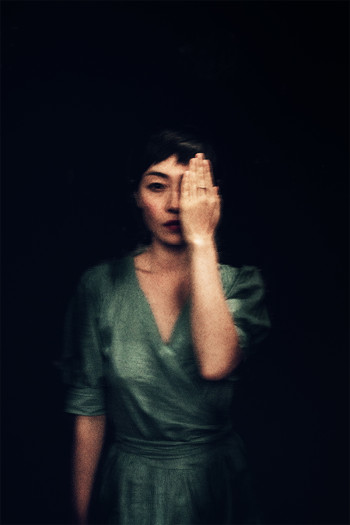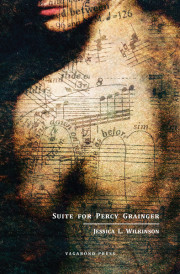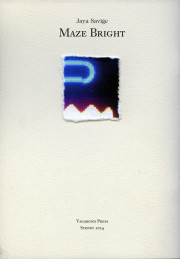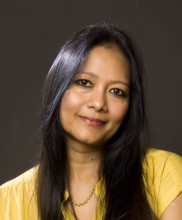Aden Rolfe reviews “Land Before Lines” by Nicholas Walton-Healey
Land Before Lines
By Nicholas Walton-Healey
Hunter Publishers, 2014
ISBN: 9780987580269
Reviewed by ADEN ROLFE
‘Is it even possible to photograph a poet?’ asks Justin Clemens in the introduction to Land Before Lines, presumably written some time after he had his photo taken for the selfsame publication. The image features Clemens casting a scowl and a defiant glare at the reader, embodying at once the character of his poem, ‘Wifebeater’, which is printed on the facing page, as well as with his distaste for this beer-swilling degenerate.
This is the basic formula of Land Before Lines: each spread juxtaposes a short poem by a Victorian poet with their image, the works entering into a dialogue sometimes deliberate, sometimes accidental. The pictures, taken by Nicholas Walton-Healey over a two-year period, are tight portraits, close-ups of the poets’ faces. The images rarely extend below the torso and never as far as the feet. At this proximity, it’s impossible not to notice the eyes, whether they’re directed at the viewer (Jo Langdon, Alex Skovron), cast up or looking away (Komninos, Maxine Beneba Clarke) or closed (Josephine Rowe, Luke Beesley). Whether imploring or vulnerable, tired or enticing, there’s a self-consciousness in all of them, a kind of performance. There’s no way not to pose, it seems, whether you embrace the camera or avoid it, nowhere to hide. In Kent MacCarter’s words, ‘I’m so here and pose’ (‘The Green Jacket’); in Jennifer Harrison’s, ‘I placed myself inside the photograph’ (‘The Image’). Even those not placing themselves – like Jennifer Compton, whose photo Walton-Healey ‘snatched/after we had finished shooting’ (‘The Hand’) – still appear to be posing, so it amounts to much the same thing. It made me think of an essay by John Jeremiah Sullivan, ‘Getting Down to What Is Really Real’, where he posits that reality television shows don’t contrive a version of the off-camera real world but simply capture people ‘in the act of being on a reality show’. In Land Before Lines, everyone is caught in the act of being in a photograph.
The focus on eyes in this volume is reminiscent of another photography-poetry collaboration: Unrecounted, wherein Jan Peter Tripp’s black-and- white photos of eyes are set alongside short poems by prose writer and poet W.G. Sebald. That collection achieves a greater stylistic consistency than this one, presumably by virtue of having only one writer to contend with, but also because Tripp’s photos, which only show eyes and are all printed in the same hues, produce a unity that’s not quite present in Land Before Lines. Walton-Healey pictures his subjects differently in different photos, places them in different spaces, with different light and colour palettes, photographed at different shutter speeds – sometimes stock still, sometimes with a smear of motion. The result is a series of images that seem linked more by content – the poets – than by form.
Clemens writes in his introduction that poetry can only ever be a gathering of singularities: different identities, ethnicities, histories, politics, styles. In light of this we can see that Walton-Healey has created a series of portraits that respond to the poets as photographic subjects, not objects, with the effect of setting up the illusion that this is a collection of poems, accompanied by photographs, not a book of photography that just happens to include poems. It’s both, of course, but it’s first and foremost the latter, something you forget because form cedes to subject.
Take, as an example, the respective portraits of Bella Li and Steve Smart. Li stands in a green dress against a black backdrop, a no-place, having just stepped out of her poem, ‘eyes glazed and fixed on what arrives petrified, moving’ (‘La Ténébreuse’). Or rather, eye. She holds her left hand over her other eye, a gold ring on her middle finger. The image is blurred, resonating with the paradoxical quiver of the poem – a combination of a still image (petrified) and fretful motion (moving). On the cover of the book, where Li is framed in close-up, she is all surface, but printed in full, a depth emerges between her figure and the viewer as she recedes into the background, shadow reaching around her shoulders. She is a painting from the chateau described in the poem. Walton-Healey’s image is a photo of a painting, ‘a copy softly of a copy softly stepping, backwards through the frame’.
Steve Smart, by comparison, is in a real, if out of focus, setting, that of a bright Victorian-era hallway, as of a university, cream walls offset by the black-and-white chequered floor. While the depth in Li’s portrait begins and ends with her, the perspective in Smart’s starts just in front of his face, the hallway receding to a vanishing point somewhere behind his head. His features are rendered in sharp focus, individual hairs stand out in high definition. The photo is cut off at the collar, and he’s lit with afternoon light that seems warmer than it is. In his poem he refers to a different light, to fluorescents, writing, ‘these lights alter: sight: thought: perception’ (‘Paris Under the Fluoros’).
Viewed side by side, the formal differences between these images don’t announce a single photographer, much less mark themselves part of the same series. It becomes interesting, then, to follow the clues in Nathan Curnow’s poem, ‘Violent Light’, toward what we might think of as Walton-Healey’s signature style. The poem recounts the event of Walton-Healey taking Curnow’s picture, the latter telling us the former ‘speaks of Caravaggio’, the Italian Renaissance artist who brought to prominence tenebrism, a style of realist painting that made dramatic use of light and shadow. The title of Li’s poem, ‘La Ténébreuse’, now takes on a greater significance.
Once you start looking for it, you can see a Caravagesque inflection throughout Land Before Lines. It’s in the spotlighting of the poets’ faces and bodies, in Walton-Healey’s interest in the way light enters a dark space and folds over the objects it finds there, in the contrast between bright foregrounds and ambiguous backgrounds, murky to the point of disappearance. The effect of these elements is further enhanced by Walton-Healey’s use of a very narrow depth of field. Many of the portraits appear crisp, the creases on foreheads and cheeks individually mapped. But take another look at Smart’s picture: you only need go as far as his ear before things are already starting to blur.
While not the most extreme use of chiaroscuro in the volume, the image of Ania Walwicz is one of the most complex. Here we have a primary light source issuing from beyond the right of the frame, concentrated on the poet’s face and hair. The ray illuminates her neckline and a patch of her jacket before being lost in its folds. The light is strong enough to give some sense of the setting – a window with articulated panes, what appears to be a flue or pipe to the right of it – without disclosing the particulars. The white light on the window seems to come from a different source above; we’re tempted to think the moon. Candles line the windowsill, their lantern houses providing no context for whether we’re indoors or out, themselves not a source of light so much as light-objects, part of the background.
As a composition of light and form, it’s a scene of which any tenebrist would be proud. Walwicz, however, takes a little convincing, at least at first:
‘…I don’t see me from out outside but I feel me now in dark in darkness a lesson now how to feel and how to be and I said to nick no no no not that photo now find someone else and something else and someone else and not this now and now I accept this just this now I accept this and any any any any any else I accept now I say yes to me yes yes yes this is me now…’ (‘Photo’)
In his role as photographer, Walton-Healey has become a closer collaborator with his contributors than the typical editor, not simply by taking their photographs, but through his presence in their poems. Walton-Healey is mentioned both obliquely and by name; the event of the photograph is often described in the poem; the echoes of photographic language inhere throughout the volume. The subjects pose by imagining how they look through the photographer’s eyes. They then compose after seeing how they actually look through this lens. An alternative title might be How Poets Feel About Being Photographed.
In his impressionistic exploration of American photography, The Ongoing Moment, Geoff Dyer asks: ‘Can we agree, in Whitman’s words, “that much unseen is also here”, that it’s not necessary to discuss – or even mention – every picture ever taken of a hat in order to learn something interesting about pictures of hats?’ Which is to say, any photographic survey opens itself up to criticisms of completeness. In the case of Land Before Lines, this will invariably about who’s represented and who’s not. What’s surprising about the book is just how many people are in it, every other page yielding a familiar face. The value here is at once contemporary, reflecting the present moment, and projected, something we can point to later and say, These were the poets who were in or from Victoria at that time. As Judith Rodriguez puts it, ‘This is the face that will survive my face’ (‘Photo Life’). So, how many portraits does it take to say something meaningful about pictures of contemporary Victorian poets? Walton-Healey’s answer: about 70.
ADEN ROLFE is a poet (works published in The Age, Best Australian Poems, Cordite, Overland) and performance writer (radio dramas commissioned by Radiotonic, Airplay). His new radio series, A Thoroughly Wet Mess, will be broadcast on ABC RN in 2015. www.adenrolfe.com








